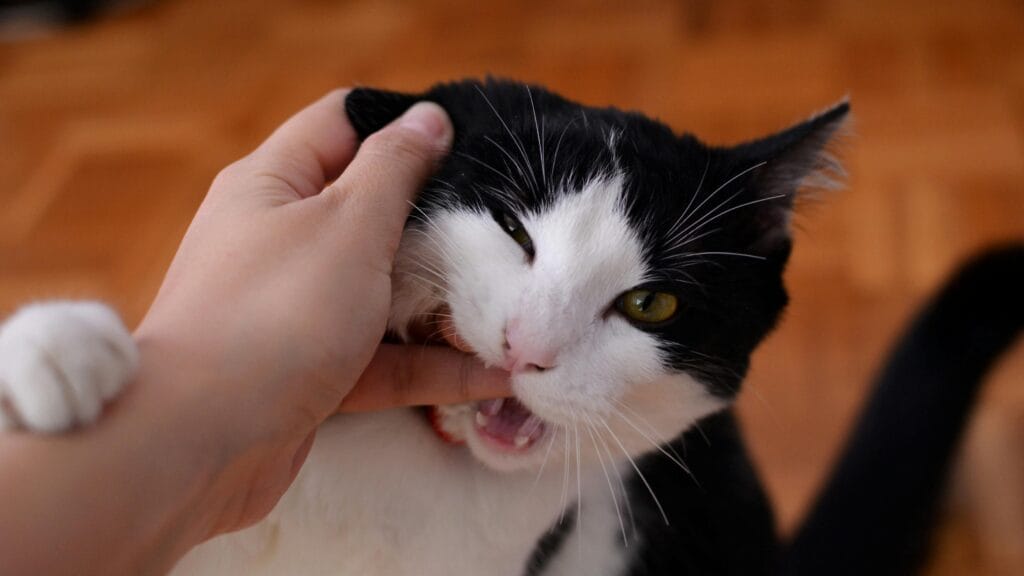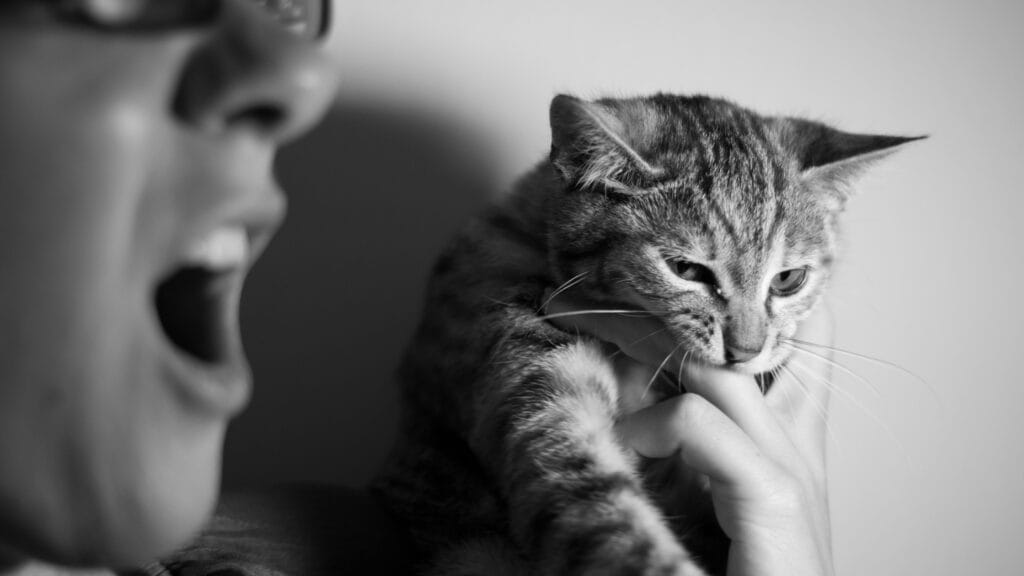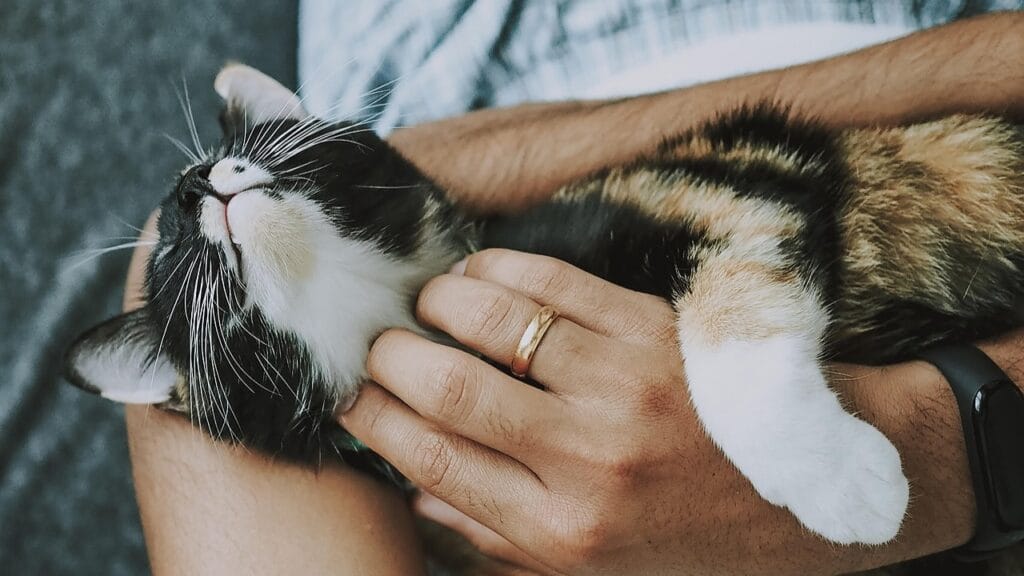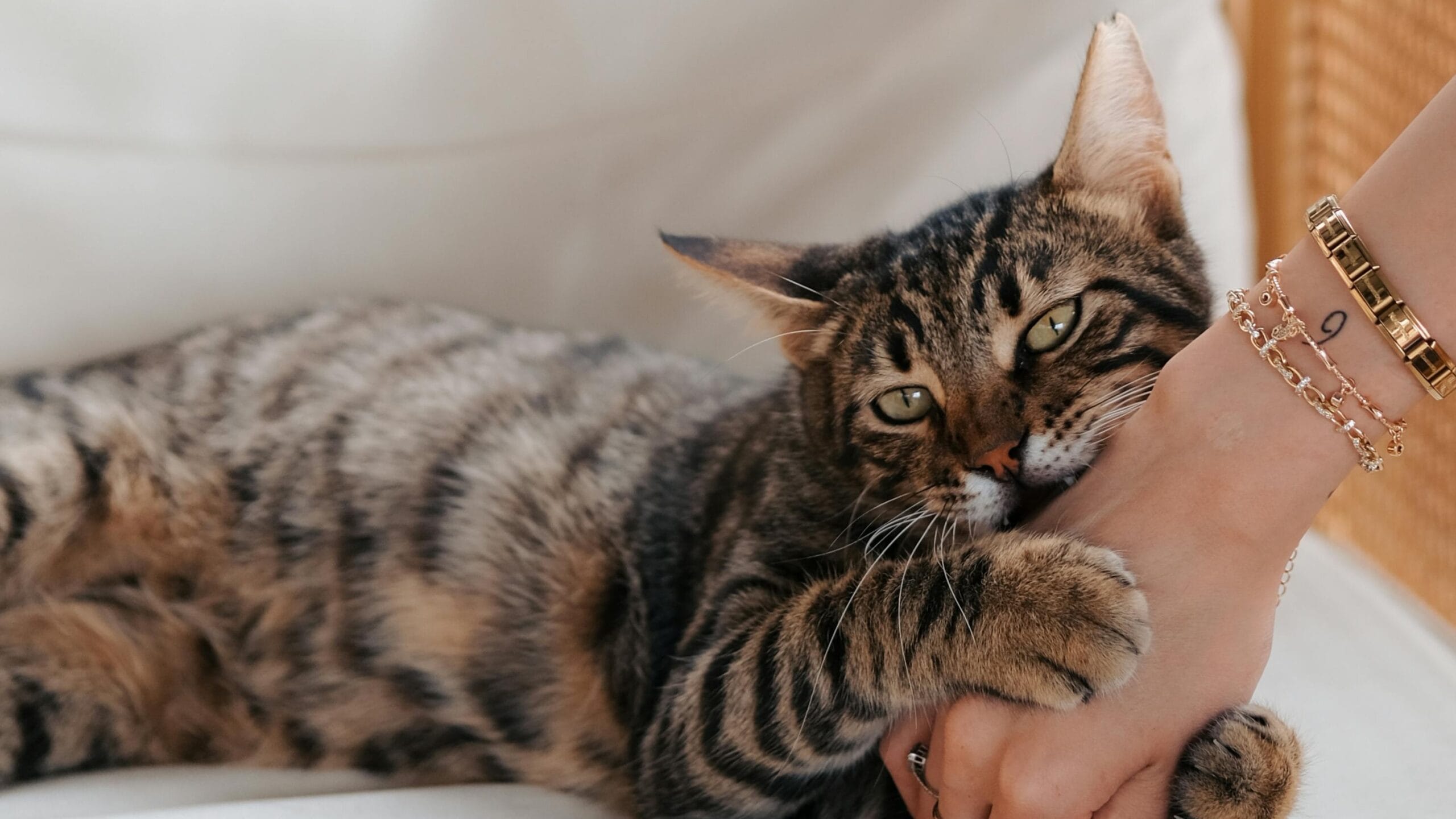Why Does My Cat Bite Me? 7 Shocking Reasons Behind This Strange Behavior
Every cat owner has experienced that sudden, unexpected nip from their feline companion. One moment you’re enjoying peaceful cuddles, and the next, sharp teeth are sinking into your hand. If you’ve ever wondered “why does my cat bite me,” you’re not alone in this perplexing predicament.
Understanding feline behavior requires delving into the complex psychological and physiological mechanisms that drive our cats’ actions. Biting behavior in cats stems from various motivations, ranging from playful instincts to serious behavioral concerns. This comprehensive exploration will uncover the seven most shocking reasons behind your cat’s biting behavior and provide actionable solutions.
Table of Contents:
The Evolutionary Foundation of Feline Biting Behavior
Before addressing why does my cat bite me, it’s crucial to understand that biting is hardwired into feline DNA. Wild cats rely on their teeth as primary hunting tools, communication devices, and defensive mechanisms. Domestic cats retain these ancestral instincts despite millennia of domestication.
Your cat’s dental structure evolved specifically for predatory behavior. Their sharp canine teeth, called fangs, are designed to deliver precise, powerful bites. When cats bite during play or interaction, they’re essentially practicing survival skills that would be essential in the wild.
Understanding Cat Communication Through Biting
Cats communicate through various modalities, including vocalizations, body language, and tactile interactions. Biting often serves as a communication method when other signals fail to achieve the desired response. When you ask “why does my cat bite me,” consider that your feline might be attempting to convey specific messages through this behavior.

Feline ethologists have identified distinct biting patterns that correspond to different emotional states and intentions. Understanding these nuanced communications can dramatically improve your relationship with your cat and reduce unwanted biting incidents.
Reason 1: Overstimulation and Sensory Overload
The most common answer to “why does my cat bite me” involves overstimulation during petting sessions. Cats possess highly sensitive nerve endings throughout their bodies, particularly along their spine, belly, and tail areas. Extended petting can overwhelm these sensory receptors, triggering a defensive bite response.
Recognizing Overstimulation Signals
Cats typically display warning signs before overstimulation biting occurs. These include tail twitching, ear flattening, skin rippling, and dilated pupils. Learning to recognize these precursors allows you to stop petting before your cat feels compelled to bite.
Managing Overstimulation Biting
Implement the “less is more” approach during interactions. Keep petting sessions brief and focused on preferred areas like the head and chin. Allow your cat to initiate contact and respect their boundaries when they signal discomfort.
Reason 2: Redirected Aggression
Redirected aggression provides another compelling explanation for why does my cat bite me. This phenomenon occurs when cats become aroused by external stimuli but cannot direct their aggression toward the actual trigger. Instead, they redirect this energy toward the nearest available target – often their human companion.
Common Triggers for Redirected Aggression
Outdoor cats visible through windows, unfamiliar sounds, or sudden environmental changes can trigger redirected aggression. Your cat may appear calm initially but then suddenly bite when you attempt to interact with them.
Prevention Strategies
Identify and eliminate triggers when possible. Use window films to block outdoor cat visibility, maintain consistent routines, and allow aroused cats time to decompress before attempting interaction.
Reason 3: Play Aggression and Predatory Instincts
Young cats and high-energy breeds often exhibit play aggression, which answers why does my cat bite me during interactive sessions. This behavior mimics hunting sequences, with your hands or feet representing prey animals.
Distinguishing Play from True Aggression
Play aggression typically involves softer bites, relaxed body posture, and playful vocalizations. True aggression includes hissing, growling, flattened ears, and harder bites intended to cause harm.
Channeling Play Energy Appropriately
Provide appropriate outlets for predatory behavior through interactive toys, puzzle feeders, and structured play sessions. Avoid using hands as toys, which reinforces the association between human body parts and prey objects.
Reason 4: Fear-Based Defensive Responses
Fear represents a primal motivation behind feline biting behavior. When cats feel cornered, threatened, or unable to escape, they may resort to biting as a last-resort defensive mechanism. Understanding this helps explain why does my cat bite me in specific situations.

Creating Safe Environments
Cats require escape routes and safe spaces within their territory. Ensure your cat has access to elevated perches, hiding spots, and quiet areas where they can retreat when feeling overwhelmed.
Building Trust Through Positive Associations
Gradual desensitization and counterconditioning can help fearful cats develop positive associations with previously threatening situations. This process requires patience but significantly reduces fear-based biting incidents.
Reason 5: Medical Issues and Pain Response
Physical discomfort often underlies the question “why does my cat bite me.” Cats instinctively hide pain as a survival mechanism, making it challenging to identify underlying medical conditions that trigger defensive biting.
Common Medical Triggers
Arthritis, dental disease, skin conditions, and internal pain can all contribute to increased irritability and biting behavior. Cats may bite when touched in painful areas or when overall discomfort levels are elevated.
Veterinary Evaluation Importance
Regular veterinary examinations can identify medical issues before they manifest as behavioral problems. Discuss any sudden changes in biting behavior with your veterinarian to rule out underlying health concerns.
Reason 6: Territorial BEHAVIOUR and Resource Guarding
Territorial instincts provide another explanation for why does my cat bite me, particularly in multi-cat households or when cats perceive threats to their resources. Cats may bite to establish dominance or protect valuable items like food, toys, or preferred resting spots.
Understanding Feline Territoriality
Cats are naturally territorial animals who establish complex hierarchies and defend their claimed spaces. This behavior intensifies in resource-scarce environments or when new animals are introduced to the household.
Managing Territorial Conflicts
Provide adequate resources for all cats in the household, including multiple food stations, water sources, litter boxes, and resting areas. This reduces competition and territorial disputes that can lead to biting incidents.
Reason 7: Learned Behavior and Attention-Seeking
The final shocking reason addressing why does my cat bite me involves learned behavior patterns. Cats are intelligent animals who quickly associate actions with consequences. If biting successfully gains attention or achieves desired outcomes, cats will repeat this behavior.
Reinforcement Cycles
Even negative attention can reinforce biting behavior. Shouting, pulling away dramatically, or providing treats to calm an aggressive cat can inadvertently strengthen the association between biting and desired outcomes.
Breaking Attention-Seeking Patterns
Ignore attention-seeking bites completely while rewarding appropriate behavior with positive attention. This approach gradually extinguishes unwanted biting while encouraging alternative communication methods.
Advanced Behavioral Modification Techniques
Professional animal behaviorists employ sophisticated techniques to address persistent biting problems. These methods go beyond basic training to address underlying psychological factors that contribute to aggressive behavior.
Desensitization Protocols
Systematic desensitization involves gradual exposure to bite-triggering stimuli at sub-threshold levels. This process helps cats develop tolerance for previously problematic situations without resorting to biting.
Counterconditioning Strategies
Counterconditioning changes emotional responses to specific triggers by creating positive associations. This technique proves particularly effective for fear-based and territorial biting behaviors.

Environmental Enrichment for Bite Prevention
Creating an enriched environment addresses many underlying factors that contribute to biting behavior. When cats have appropriate outlets for natural behaviors, they’re less likely to resort to inappropriate biting.
Physical Enrichment Elements
Vertical spaces, scratching surfaces, hunting opportunities, and varied textures provide essential physical stimulation. These elements satisfy natural feline needs and reduce stress-related behavioral problems.
Mental Stimulation Requirements
Puzzle feeders, rotating toy selections, and interactive play sessions provide crucial mental stimulation. Bored cats often develop behavioral problems, including inappropriate biting, as outlets for unused mental energy.
The Role of Socialization in Bite Prevention
Early socialization experiences significantly impact adult biting behavior. Kittens who receive appropriate socialization during critical developmental periods are less likely to exhibit problematic biting as adults.
Critical Socialization Periods
The prime socialization window occurs between 2-7 weeks of age. During this period, positive experiences with humans, handling, and various stimuli create lasting behavioral foundations.
Adult Socialization Possibilities
While adult socialization requires more time and patience, it remains possible to modify established behavior patterns through consistent, positive training approaches.
When to Seek Professional Help
Persistent biting behavior that doesn’t respond to basic interventions may require professional assistance. Certified cat behaviorists, veterinary behaviorists, and experienced trainers can provide specialized guidance for complex cases.
Warning Signs Requiring Professional Intervention
Biting that causes significant injury, escalating aggression, fear-based behavior that doesn’t improve with environmental modifications, or biting associated with other concerning behavioral changes warrants professional evaluation.
Finding Qualified Professionals
Look for certified animal behaviorists, veterinary behaviorists, or trainers with specific feline expertise. Professional organizations maintain directories of qualified practitioners who can address serious behavioral concerns.
Long-term Management Strategies
Successfully addressing why does my cat bite me requires commitment to long-term management strategies. Behavioral change takes time, consistency, and patience to achieve lasting results.
Consistency in Approach
All household members must apply behavioral modification techniques consistently. Mixed messages confuse cats and slow progress toward behavior change goals.
Patience and Realistic Expectations
Behavioral modification is a gradual process that requires patience and realistic expectations. Celebrate small improvements while working toward long-term behavior change goals.
Prevention Through Understanding
The ultimate answer to “why does my cat bite me” lies in developing deep understanding of feline behavior, communication, and needs. This knowledge enables proactive prevention rather than reactive management of biting incidents.
Building Stronger Bonds
Understanding your cat’s individual personality, preferences, and triggers allows you to build stronger, more trusting relationships. These bonds naturally reduce conflict and biting behavior over time.

Ongoing Education
Continue learning about feline behavior through reputable sources, professional development opportunities, and observation of your own cat’s unique patterns and preferences.
Conclusion
Understanding why does my cat bite me involves recognizing the complex interplay of evolutionary instincts, individual personality traits, environmental factors, and learned behaviors. The seven shocking reasons explored in this comprehensive guide provide frameworks for understanding and addressing biting behavior effectively.
Remember that biting behavior often serves important functions for cats, whether communication, stress relief, or natural expression of predatory instincts. Rather than simply trying to eliminate biting, focus on providing appropriate outlets for these natural behaviors while protecting yourself from unwanted aggression.
Success in addressing biting behavior requires patience, consistency, and willingness to see situations from your cat’s perspective. With proper understanding and application of behavioral principles, you can develop a harmonious relationship built on mutual respect and clear communication.
FAQ
Why does my cat bite me gently during cuddles?
Gentle biting during affectionate moments, called “love bites,” typically indicates overstimulation or your cat’s attempt to communicate. Watch for warning signs like tail twitching and give your cat space when they signal they’ve had enough petting.
Should I punish my cat for biting?
Punishment is counterproductive and can increase fear-based aggression. Instead, redirect the behavior, remove yourself from the situation calmly, and address underlying causes like overstimulation, fear, or medical issues.
How can I tell if my cat’s biting is playful or aggressive?
Playful biting is usually gentler, accompanied by relaxed body language and purring. Aggressive biting involves harder pressure, hissing, growling, flattened ears, and tense body posture. The context and intensity help distinguish between the two.
When should I be concerned about my cat’s biting behavior?
Seek veterinary or behavioral consultation if biting suddenly increases, causes significant injury, is accompanied by other behavioral changes, or doesn’t respond to basic management techniques. Sudden behavior changes may indicate underlying medical issues.
Did you enjoy this article?
Help other pet lovers benefit too — Share it on social media! 🐾💚


Leave a Reply